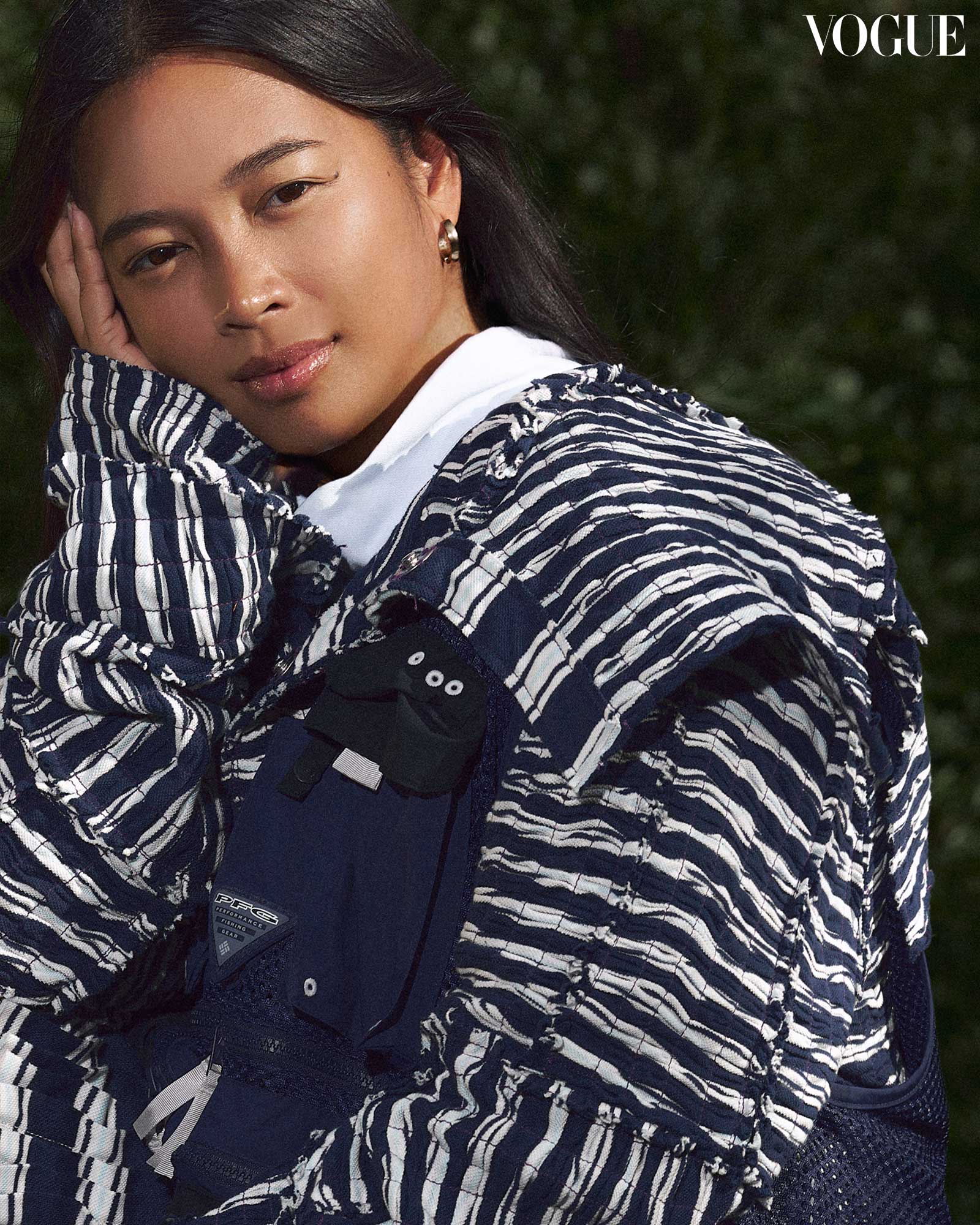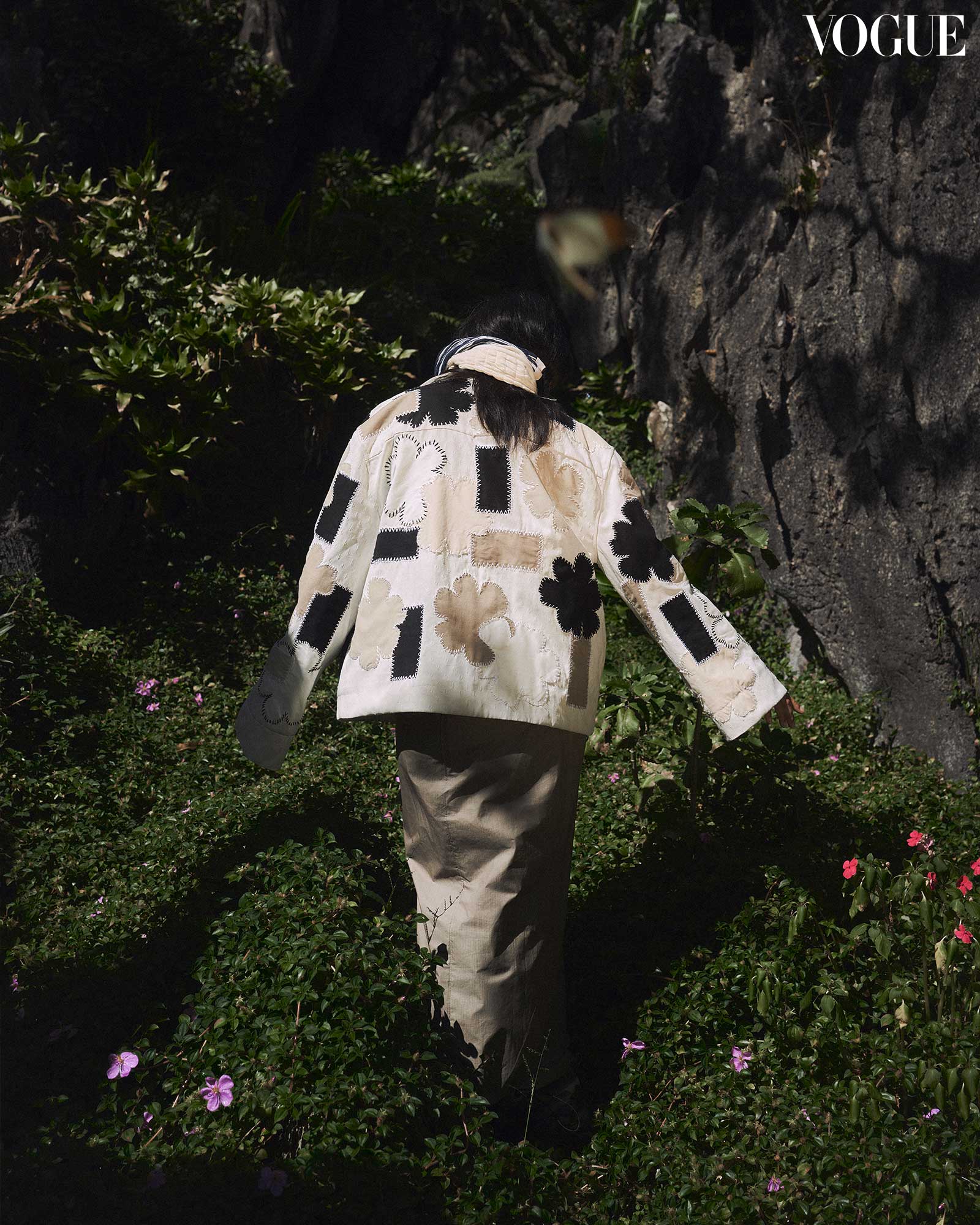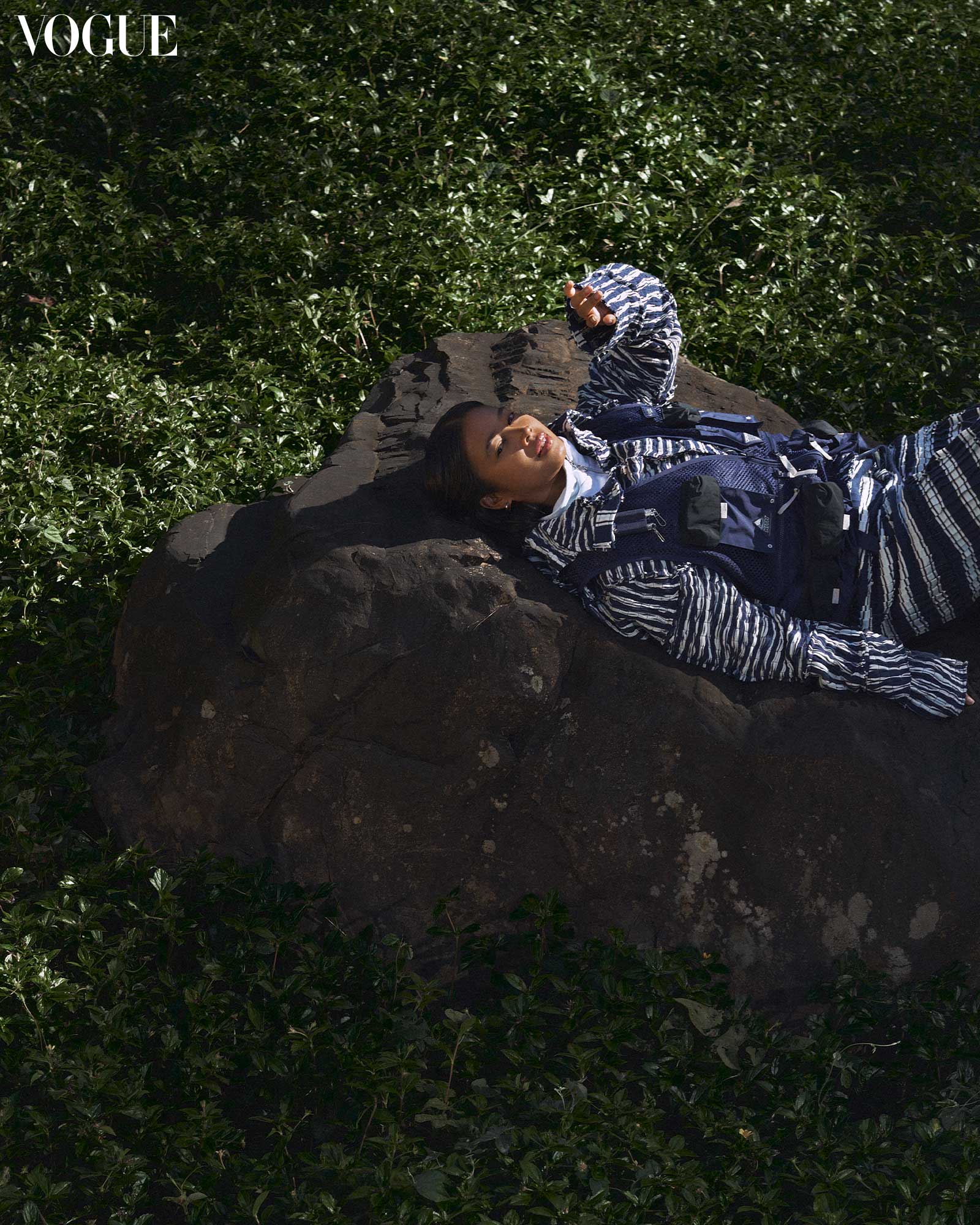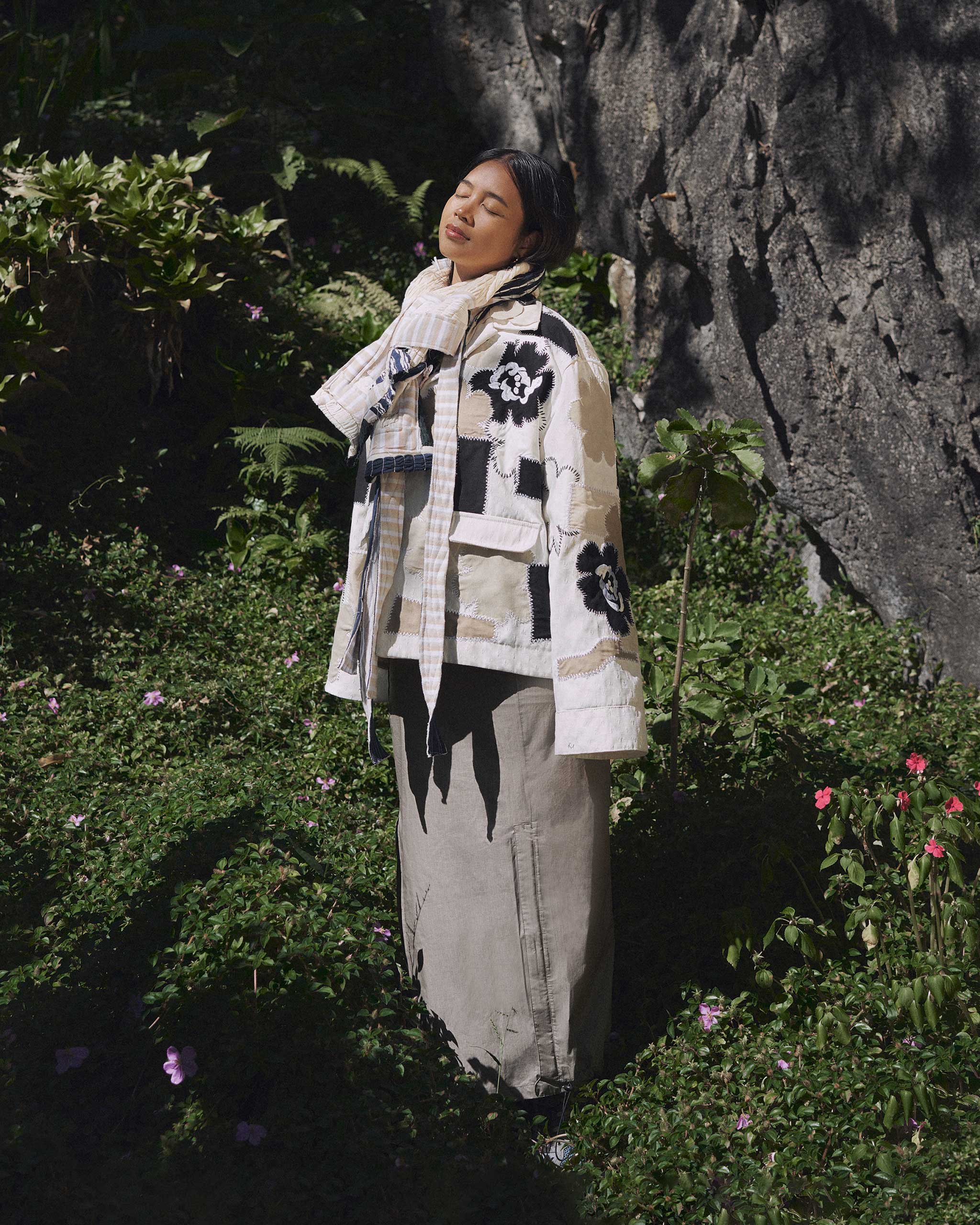RENZ REYES jacket, CARL JAN CRUZ bib, IT’S VINTAGE cargo skirt, SALOMON sneakers at R.O.X. Photographed by Artu Nepomuceno for the February 2024 Issue of Vogue Philippines
Camille Rivera and Oceanus Conservation are bringing life back into communities through mangroves.
Like many great stories, Camille Rivera’s conservation journey began with a moment of wonder. She was a child enjoying a beach day with her family in Camiguin when she decided to put a seemingly dormant starfish back into the water. “When I put it back in the ocean, I saw the feet of the starfish move,” she says. “It’s been out of the water for hours, right? That made me very curious.”
From witnessing that “rebirth,” her curiosity eventually turned to a passion for bringing life back to different communities. Today, Camille runs Oceanus Conservation, a non-profit she founded over the pandemic whose focus and expertise are on the planting and preservation of mangroves. According to its mission statement, it aims to “protect and restore blue carbon habitats and the surrounding wildlife to contribute to the conservation, education, and community development of the Filipino people.” They believe in “sustaining biodiversity in order to provide ecosystem services such as food security for the Filipino people in the years to come.”
Having grown up in landlocked Bukidnon, Camille was always surrounded by nature. She was raised by her father Francis, a horticulturist, and mother Mayette, a social scientist. “Bukid- non has clear skies, no noise pollution, no light pollution,” she shares. “And so I was exposed to that.”
She enjoyed going to the beach, which was about an hour away from her home. Camille would stay all day in the water until her hands would go wrinkly. Though she didn’t know how to swim, and despite being initially afraid of the ocean, she felt it called to her. All her fears disappeared when she finally saw what lies underneath the water’s surface.
She eventually pursued marine biology both at Xavier University and through the Erasmus Mundus program in different European countries.

Mangroves weren’t a particular interest for Camille at university. That changed when she worked for Marine Conservation Philippines in Siaton, Negros Oriental.
“I would manage communities in different ecosystems,” Camille shares, adding that this included marine protected areas and mangrove ecosystems. “I went there every day. I would understand how they’re connected with nature, how communities get back and get resources from nature.”
There, she met Evelyn, a community leader. One day, she asked Rivera to go with her to check out the flora in the area. “We would go into this forest [and] I remember [it was] super peaceful. You hear the sounds of the birds. And then she would just point out the names of the trees as if she knows each one like a best friend. I was so shocked. She named them and I was writing it down really fast,” she recalls.
They then came upon one tree that Evelyn didn’t know. Camille took a photo of it and later discovered that it was a Campostemon Philippinensis, an endangered mangrove specie. Both women expressed a desire to protect it, which also sparked a burgeoning affection for mangroves in Rivera. “At that moment, I realized that mangroves are cool. It’s so unappreciated and undervalued,” she says. A mangrove is full with life apart within it, above it, and underneath it: birds, bats, fireflies, crabs, fish. “No one knows how beautiful it is… I felt that at that time with Evelyn I wanted to give mangroves a voice because sila ‘yung hindi pinapansin (they weren’t being given attention).”
There is always a focus on corals, whales, and mammals, Camille says, but rarely on ecosystems or habitats. Mangroves in particular can solve a host of needs. “For example, there is a mangrove that specifically protects us from a storm, there’s a species just for that. There’s a mangrove, because of its root system, that would protect from soil erosion. If you want to see more crabs, there is also a type of mangroves for it,” Rivera says. According to her, many communities during the COVID lockdowns actually sourced mussels and oysters for their daily food from surrounding mangroves.
Food security, as mentioned, is one of the main thrusts of Oceanus. “I always have this saying: There’s a time where you plant the tree. And there’s a time where you sit under the shade. So there’s that gap in between because it takes time for you to receive the benefits of you planting the tree, right?” Camille, an International Union for Conservation of Nature (IUCN) changemaker, says. “That gap is where you have to fill fisheries fill a livelihood, and so we do try our best to fill in that need of the community.”

A lot of their efforts go into turning abandoned fish ponds into mangroves. “It’s phase by phase and it takes a while. We raise the soil, we plant, and then we reintroduce crab, shrimp, or fish,” Rivera, also a National Geographic Society Explorer in 2022, explains. “Right now we’re trying to pilot it in Surigao del Sur. So it’s still a while because we’re making sure na there’s enough height of the mangroves before we introduce some crabs, and those crabs are supposed to help sustain the community, the livelihood, na kung wala silang trabaho or wala silang pagkain [if they don’t have a job or if they don’t have food] they could get it from that ecosystem.” They found success with an earlier project in Aringay, La Union.
Aside from being natural water filters, mangroves are also blue carbon ecosystems: they capture carbon from the atmosphere. “I think we just need to bring our connection back to nature, you know, like, understand that there’s so many benefits that they could give us,” Camille says.
Then, there are the benefits that cannot be measured in in- come, meals, or carbon absorption. While talking to a fisherman, Rivera also realized that it could be a way of improving mental health. “He said, ‘you know, I like mangroves. It’s a nice place to relax and recall, muni-muni [reflect],” Camille recalls. “He would go there to the boardwalk that we built for them. And he would just sit down daw, and just relax. Sometimes you don’t do that as a service. There’s that benefit that no one sees.”
At Oceanus, Camille shares that they have three pillars that they focus on when they take on a project. The first is to make a proper biophysical assessment of the situation. “We would really look at the Science of Things,” she explains. “The second is community engagement. Kung wala ’yung community doon [if the community is not there], we won’t work. It won’t be sustainable.” A community can become invested into their future by having them be involved in the process such as helping in the reforestation efforts or acting as data gatherers; like Evelyn, many can spot the plants and animals that naturally grow in their own locale. “Through collecting data, they earn an income,” Rivera says. “That’s what we call a conservation income.” Given that a mangrove could take a couple of years to properly grow and effect change in a locale, short term income matters.
Finally, Camille says that to ensure the sustainability of a project, it needs institutional support. It needs an alignment with the government. If they do not do so and if the LGU’s plans differ significantly from their project’s goals, it would be difficult to go up against them.
While the work is filled with purpose, the Oceanus director and co-founder admits it has its share of struggles. “I would have doubts, like just questioning ‘is this even the proper way’?” she shares. “But you just learn it through the ropes, but you learn it by doing. You look at other organizations, what they’re doing and learn from them. And I’m actually really fortunate enough that I had friends from the NGO field that would help how to do things. And so there’s a lot of collaboration and helping each other when we have to work in the environmental space.”

But, there’s also competition. “There are bigger NGOs. The funding they will get will not trickle down to smaller NGOs. So that was also another challenge na parang they will just absorb everything and wala nang naiwan [for others], and that becomes a challenge sa lahat ng small NGOs because we com- pete for the grants.”
Still, there are those who are glad to see new organizations like Oceanus such as Dr. Jurgenne Primavera. Rivera says she has been following in the footsteps of the marine scientist from Mindanao, who has been working with mangroves and promoting sustainable fish farming for years and was part of Time Magazine’s Heroes of the Environment in 2008. Dr. Primavera told Camille that she was happy to finally see a young person taking on the work that she’s been doing. She advised her to be patient. “I think it’s a lot of dealing with bureaucracy that you have to deal with, which is true and that’s what we’re dealing with now. But that goes with being as young as we are, we can still push for it,” Camille says. “But the opposite side of it is that we’re not taken seriously. Being a young person doing environmental work, you have to prove yourself all the time.”
Youthful creativity and drive remain the hope in seeing lasting change happen when it comes to the environment. At an IUCN event she attended last year, Camille was surrounded by young innovators and activists. “That really gives me hope because parang the push, the tenacity of young people is there. We won’t give up until we see the solution that we want to see. I think that’s lost on other generations. I would talk to other generations and they would say like, ‘yan na e,’ [it is what it is] or ‘wala ng magawa ’yan na ’yung reality’ [you can’t do anything about it, that’s reality],” she says. “And for me, no, I don’t want to accept that. And I feel like we just—if you just bring all the young people together—and there’s so many of them, I’ve been in different groups—they have so many ideas. And you have to funnel that energy, their energy, and ask ‘what do we want to create’?”
She wants to continue bringing that voice to more communities. “What I know and all this knowledge that I’ve seen, all the knowledge that I’ve learned, I just want to show that to so many people. That’s why I’m doing what I’m doing now,” Camille shares. “I am very fortunate that I actually have this job because not all would be able to find their passion in environmental space. But I’m privileged that I’m dedicating my life to conservation, and I have hope that other people, other young people, are doing the same.”
On discovering her deep passion for the ocean
“It’s a battle,” Camille says, describing her journey to marine biology. Although she fell in love with the ocean early on, it wasn’t always in her plans to become a marine biologist. Expected to take a more conventional path, her parents and relatives wanted her to pursue medicine. However, when she watched The Cove, a 2009 documentary about dolphin hunting operations in Japan, Camille couldn’t shake off her desire to help protect ocean life.
“After watching the documentary, I cried until 1 AM and couldn’t stop crying,” she shares. “It’s one of those moments when I realized, ‘This is what I want.’ I want to pursue marine [biology] because I wanted to be one of those people that would protect dolphins.”
Entering college, she took marine biology without hesitation. “The moment I saw marine biology on the course list, it was no question at all. I didn’t even put a second course option in my application,” she shares. As passionate as she was about studying marine biology, Camille was still unsure what path to take after finishing her Bachelor’s degree. She was torn between pursuing her passion and following her parents’ wishes. “It was in that moment that I had to balance what my parents want and what I want,” she says. As a compromise, she applied for medical school and various marine biology Master’s degree programs overseas.
“Being a young person doing environmental work, you have to prove yourself all the time“
Camille applied for over twenty different scholarship programs at the time. As she received rejection letters, she began to lose hope. “I told myself and the universe that if I don’t get a scholarship, I’ll pursue medical school,” she shares. As fate would have it, Camille was accepted into the Erasmus Mundus International scholarship program. She received her MSc in Marine Biodiversity and Conservation in Europe at the University of Ghent, Belgium, and a training scholarship from the Center of Excellence in Observational Oceanography at the Alfred Wegner Institute in Germany.
Finding her path in marine biology
Camille’s path to founding a non-government organization (NGO) wasn’t linear. When she returned to the Philippines, she went into a depressive state and felt lost. According to her, there are two paths marine biologists could take in the Philippines: go into academia as a researcher or work at a conservation NGO.
At that point, Camille’s mind wasn’t open yet to work at a conservation NGO. “Once you are trained in this academic world, you’re surrounded by people who all think the same way. I was thinking, ‘Okay, so academic lang pala.’ But later on, I realized that there is an NGO and a way to go into conservation,” she says.
Research is a vital part of marine biology, but Camille was unsatisfied with her academic work. “We would find articles, write papers, and all that. But when the project finishes, everything’s done. You’re not even connected again to the people. You’re not connected to the project again,” she says.
It was in Negros Oriental where she would find her love for conservation. Camille shared her knowledge and promoted ocean literacy as an education officer at the Marine Conservation Philippines. Speaking of the experience, Camille shares, “That setup as a marine biologist was interesting because I got to translate my scientific knowledge to local knowledge and have that impact. That’s something that bridges it all together because not all scientists, not all of them know how to translate their science to the public.”
Then, the COVID-19 pandemic happened. “We lost all of our jobs during the pandemic because the revenue of the NGO where I was working came from volunteer contributions. All the [foreign] volunteers returned to their home countries, so we lost all our jobs,” she shares. Expressing her troubles to her then-boyfriend, now-husband, Camille realized she wanted to start her marine conservation organization.
“When I started, we didn’t have any assets. We didn’t have anything big enough to create a big impact. What I had that time was a few savings left from my previous organization,” she shares. She would create a storybook called Cory and the Ocean Adventures from these savings. “I told a friend of mine that I wanted to create a bilingual storybook about the ocean. And she said, ‘What do you mean by bilingual?’ And I told her that I haven’t found any ocean storybooks that are in both Bisaya and English,” she shares.

Together with her friend Aoibheann Gillespie-Mules, a fellow marine life expert, they began to work on the project. Camille’s inspiration for the story came from her desire to promote ocean literacy. “I was in Negros, and I asked the kids, ‘What is coral in your language?’ I asked, ‘Is coral a plant, an animal, or a stone?’ And all of them said it’s a stone,” she shares. “When I told them that a coral is an animal, they were shocked. That was the inspiration and the beginning for the NGO.”
From there, Camille would receive funding and support for her organization, Oceanus Conservation. “After ocean literacy, I would pitch topics, stories, or products, and I found people that supported me. I found people who wanted to fund the organization. It just came from a small idea of ocean literacy,” she says. Camille’s team expanded to nine people from working alone as a one-woman team. They are working on four ongoing projects: blue carbon conservation, coral reef monitoring, community development, and ocean education and outreach.
Oceanus Conservation has three mangrove nursery banks, planted 14,415 mangrove saplings, 71 hectares of mangroves saved from degradation, 117 ocean bilingual storybooks distributed, 240 community members trained, and 739 young people engaged in its Ocean campaign.
Diving into the future
Reflecting on her journey, Camille describes the experience as “puzzle pieces falling into place.” “Every step of the way was a realization. And it was a big realization of where I am right now and why I do this work,” she says. “I had my fair share of ‘down’ moments when I thought, ‘Am I still going to do this?’ But what pushed me was remembering when my partner said, ‘When there’s that fear, that’s when you push.’ Because that’s the time when you grow more.”
Camille is hoping for two things for the future of marine biology in the Philippines: “One, I want there to be more marine biologists. I hope more people like us will protect the ocean because there are so few of us, and the ocean is huge. The second is more on the implementation and enforcement on the government side. In my mangrove conservation and restoration field, I saw all the good laws we have, but it’s not implemented well.”
She continues, “I just hope that the Philippines will push for more rights with nature, not just for Filipino people, but for nature, because we are given so many resources. I want people to see that we are all connected here and must start protecting the environment.”
Introduction by Jacs T. Sampayan. Profile Extension by Daphne Sagun. Photographs by Artu Nepomuceno. Fashion Director: Pam Quiñones. Beauty Editor: Joyce Oreña. Stylists: Renee de Guzman, Roko Arceo. Makeup: Angeline Dela Cruz. Hair: JA Feliciano, Mong Amado. Talents: Ann Dumaliang, Bella Tanjutco, Billie Dumaliang, Camille Rivera, Issa Barte, Nicola Sebastian, Tasha Tanjutco. Art Director: Jann Pascua. Producers: Anz Hizon, Bianca Zaragoza. Multimedia Artist: Gabbi Constantino. Production Assistant: Bianca Custodio, Patricia Co, Patricia Villoria, Tinkerbell Poblete. Photographer’s Assistants: Aaron Carlos, Choi Narciso, Mark Tijano, Odan Juan, Sela Gonzales, Rojan Maguyon. Stylist’s Assistants: Giselle Barnachea, Neil De Guzman, Ticia Almazan. Makeup Assistant: Jian Santos. Hair Assistants: Kyle Denzel Celis, Marjorie Caballos. Shot on location at Masungi Georeserve.
- A Lifetime Of Growing And Protecting Forests: Ann And Billie Dumaliang On Their Ongoing Battle For Conservation At Masungi Georeserve
- Creativity As Catalyst: TAYO Philippines Founders Tasha and Bella Tanjutco On Using Creative Solutions For Climate Work
- Issa Barte On Amplifying Indigenous Voices And The Role Of Culture In Climate Action
- Riding Waves, Growing Stories: Nicola Sebastian’s Path To Climate Justice In The Philippines

